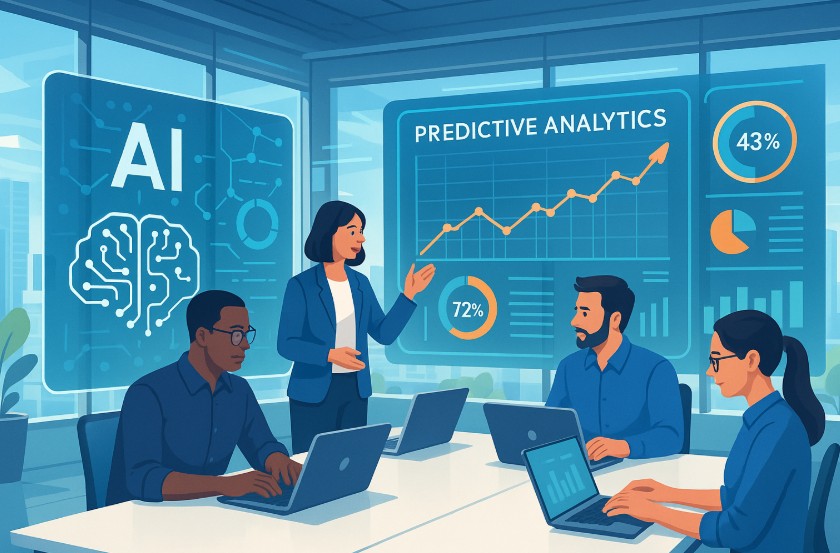
How can organisations protect their confidential information in an age where cyber threats are advancing faster than ever? What measures ensure that sensitive customer details, financial records, and intellectual property remain safe from both external hackers and careless employees? The answer often lies in DLP in cyber security, which stands for Data Loss Prevention.
Data Loss Prevention is more than just a technical tool. It is a framework of policies, practices, and technologies that helps businesses safeguard data in all its states, whether it is stored on devices, actively being used in applications, or moving across networks and cloud platforms.
Without DLP, organisations risk financial losses, reputational damage, and penalties under strict regulatory frameworks such as GDPR in Europe, HIPAA in the United States, or CCPA in California.
What is DLP in Cyber Security?

DLP in cyber security refers to a set of solutions designed to detect, monitor, and prevent the unauthorised movement of sensitive information outside the boundaries of an organisation. Sensitive information can include personally identifiable information (PII), intellectual property (IP), financial documents, and trade secrets.
DLP ensures that this data cannot be copied to unauthorised devices, uploaded to unsafe cloud platforms, or shared externally without permission.
It is also used to stop accidental leaks, such as when employees mistakenly email confidential files to the wrong recipient. By taking a data-centric approach, rather than only focusing on system or network defences, DLP plays a crucial role in modern cyber security.
How Does DLP Work in Cyber Security?
DLP operates through a combination of policy enforcement and content analysis. Organisations first define what constitutes sensitive information within their systems.
This can range from credit card numbers and health records to proprietary designs or internal reports. Once identified, DLP tools apply rules that control how this data is used, shared, and stored.
Different techniques are used to recognise sensitive data:
- Rule-Based Analysis identifies structured patterns, such as a sequence of numbers resembling bank account details.
- Exact File Matching uses digital fingerprints of files to ensure they are not tampered with or transferred without permission.
- Statistical Analysis employs machine learning to recognise unusual behaviours or anomalies in data use.
- Pre-Built Categorisation applies regulatory standards like GDPR or HIPAA to automatically flag relevant data sets.
The process of monitoring applies across three primary states of data:
- Data at Rest refers to information stored on servers, databases, or endpoints. Although less mobile, this type of data is often a prime target for cybercriminals.
- Data in Use covers information currently being accessed or processed, such as when an employee edits a financial spreadsheet.
- Data in Motion involves data moving across networks or cloud services, which is often the most vulnerable state due to exposure during transmission.
By safeguarding data in all three states, DLP ensures that sensitive content remains under the organisation’s control.
Why Do Organisations Need DLP?

The necessity of DLP arises from the rising scale of cyber threats and the increasing value of data. In the first half of 2019 alone, more than 3,800 breaches were reported globally, exposing billions of records. Since then, the number and complexity of attacks have only grown.
Organisations need DLP for several reasons. First, it provides defence against costly data breaches. A single incident involving customer financial data or healthcare information can result in severe financial penalties and irreparable reputational harm.
Second, DLP is vital for compliance. Regulatory frameworks such as GDPR, HIPAA, and CCPA place strict obligations on businesses to handle personal data securely, with non-compliance leading to fines running into millions.
DLP also helps protect intellectual property, which can include patents, software source code, or confidential designs. The loss of such assets to competitors or criminals can cripple innovation and market competitiveness.
Furthermore, insider threats, both malicious and accidental, are a growing concern. Employees, contractors, or partners with access to sensitive data can pose risks either deliberately or through negligence. DLP offers visibility into user activity, reducing these risks significantly.
What Types of Data Loss Prevention Exist?
There are three main types of DLP, each addressing specific risks within the digital environment.
| Type of DLP | Description | Example Use Case |
| Network DLP | Monitors data as it moves across organisational networks. It blocks unauthorised transfers over email, messaging systems, or file uploads. | Preventing an employee from emailing a customer database to a personal account. |
| Endpoint DLP | Operates directly on devices such as laptops, desktops, and removable storage. It prevents data being copied or transferred to unauthorised media. | Blocking confidential files from being saved to a USB drive. |
| Cloud DLP | Protects data stored and shared on cloud platforms like Microsoft 365, Google Workspace, or Dropbox. It enforces security policies for remote and hybrid workers. | Restricting external sharing of documents stored in cloud-based collaboration tools. |
Together, these three deployment models create a layered approach that secures data wherever it resides or moves.
What Functions and Benefits Does DLP Provide?

The benefits of adopting DLP are wide-ranging and extend beyond technical security. One of its core functions is data identification and classification. DLP tools scan environments to locate sensitive content and apply labels or tags.
Once identified, policies can be enforced to restrict its use. This leads directly to the next benefit policy enforcement. Whether blocking the transfer of confidential spreadsheets over email or encrypting files stored on devices, DLP ensures that rules are consistently applied.
Another important function is monitoring and detection. Security teams receive alerts when suspicious activity occurs, such as repeated attempts to copy protected files. This enables timely intervention and reduces the risk of a full-scale breach.
DLP also plays a pivotal role in compliance management. By preventing misuse of personal data, organisations can demonstrate adherence to GDPR, HIPAA, or other regulatory frameworks. This not only avoids penalties but also builds customer trust.
Finally, DLP addresses the challenge of insider threats. It mitigates risks posed by employees, whether intentional or careless, by monitoring behaviour and controlling access.
For example, if a staff member attempts to upload intellectual property to an unauthorised cloud storage account, the system can immediately block the activity.
What Data Threats Can DLP Defend Against?
Data Loss Prevention helps organisations defend against a wide range of threats, from sophisticated cyberattacks to unintentional mistakes.
- Extrusion attacks involve external actors attempting to extract sensitive data from within an organisation’s network. Ransomware campaigns, such as the WannaCry outbreak in 2017, highlighted how attackers can penetrate systems and demand payment for stolen or encrypted information.
- Insider threats originate from within. In 2016, the UK technology firm Sage suffered a breach when an employee accessed customer records without permission. Insider threats can also come from contractors or third parties with authorised access.
- Unintended exposure is another significant risk. This can occur when employees fail to follow security protocols or when systems lack proper access restrictions. In 2011, cybersecurity firm RSA was compromised after phishing emails tricked staff into revealing credentials, exposing millions of authentication tokens.
DLP combats these risks by continuously monitoring file movements, identifying unusual behaviour, and automatically blocking unauthorised actions.
How Does DLP Support Compliance Requirements?

Compliance is one of the most pressing reasons organisations adopt DLP solutions. With stricter privacy laws globally, the penalties for mishandling sensitive data are severe.
For European businesses, the General Data Protection Regulation (GDPR) sets out clear rules for protecting personal information and grants individuals more control over their data. Violations can result in fines of up to 4% of annual global turnover.
In the United States, the Health Insurance Portability and Accountability Act (HIPAA) requires healthcare providers to protect medical records and patient data.
Failure to comply can lead to heavy civil and criminal penalties. Similarly, the California Consumer Privacy Act (CCPA) grants residents of California rights over how companies collect, use, and share their personal data.
DLP supports compliance by automatically identifying regulated data, classifying it, and preventing mishandling. It also provides reporting features that help businesses demonstrate compliance during audits, reducing the risk of penalties.
How Can Businesses Deploy an Effective DLP Strategy?
Deploying DLP effectively requires more than simply installing a tool. Organisations must start by defining what constitutes sensitive data within their operations. This might include customer information, employee records, or intellectual property. Once identified, a DLP policy must be created that outlines how this data should be handled, stored, and transmitted.
Policies should define the locations where data is protected, the conditions under which it can be accessed, and the actions to be taken when risks are detected. A well-defined policy ensures that protection measures are consistent and enforceable.
Businesses must also monitor user activity proactively. This means not only protecting data when it is stored but also when it is in use and in transit. For example, an employee working remotely on financial documents should not be able to upload them to a personal cloud storage service without authorisation.
Employee education plays a critical role in the success of DLP. Many breaches occur due to human error, and awareness training helps staff understand the importance of secure data practices.
Finally, organisations should integrate DLP with other security systems such as Security Information and Event Management (SIEM) and Intrusion Prevention Systems (IPS) to create a holistic defence.
What is the Future of DLP in Cyber Security?
The future of DLP is shaped by advancements in artificial intelligence and the growing reliance on cloud and remote working environments. AI-driven DLP systems are already being used to improve detection accuracy by learning normal patterns of data use and identifying anomalies more effectively than traditional rule-based systems.
Cloud-native DLP solutions are also becoming essential as organisations migrate more of their operations to SaaS platforms. These tools provide seamless integration with services like Microsoft 365 or Google Workspace, ensuring that cloud data is monitored and protected without interrupting productivity.
Another trend is the integration of DLP with Zero Trust security models. This approach assumes no user or device should be trusted by default, even if they are inside the corporate network. By combining Zero Trust principles with DLP, organisations can ensure that sensitive data is protected even if attackers gain access to internal systems.
As businesses continue to adopt remote and hybrid working, DLP will remain at the forefront of strategies to secure data across increasingly decentralised environments.
Conclusion
In conclusion, DLP in cyber security is one of the most vital components of a modern organisation’s defence strategy. It protects sensitive information, enforces policies, supports compliance, and prevents both external and internal threats. By covering data at rest, in use, and in motion, DLP provides comprehensive visibility and control over an organisation’s digital assets.
Although implementing DLP can be challenging due to technical complexity and cost, the long-term benefits of reduced breaches, regulatory compliance, and customer trust outweigh these obstacles. In an era where data is among the most valuable assets, DLP ensures it remains safe, secure, and within the control of those who own it.
FAQs
What industries benefit most from DLP?
Industries such as healthcare, finance, government, and technology are most dependent on DLP because of the volume and sensitivity of the data they handle.
Can DLP stop all insider threats?
While DLP cannot completely eliminate insider risks, it reduces them significantly by monitoring behaviour, restricting access, and alerting security teams to unusual activity.
How does DLP differ from encryption?
Encryption protects data by converting it into unreadable code, while DLP ensures that data is not moved, accessed, or shared without authorisation. They are complementary solutions rather than replacements.
Does DLP work with cloud applications?
Yes, modern DLP solutions include cloud-native features that integrate with platforms such as Microsoft 365, Google Workspace, and Dropbox to monitor and protect cloud data.
What role does AI play in modern DLP?
AI enhances DLP by recognising patterns, detecting anomalies, and reducing false positives, making security systems more efficient and adaptive to emerging threats.
How can small businesses afford DLP?
Many vendors offer scalable, cloud-based DLP solutions that are affordable for smaller businesses, enabling them to achieve effective data protection without heavy infrastructure costs.
Can DLP ensure GDPR and HIPAA compliance?
Yes, DLP supports compliance efforts by classifying, monitoring, and protecting data covered under regulations like GDPR and HIPAA, while also providing reporting for audits.